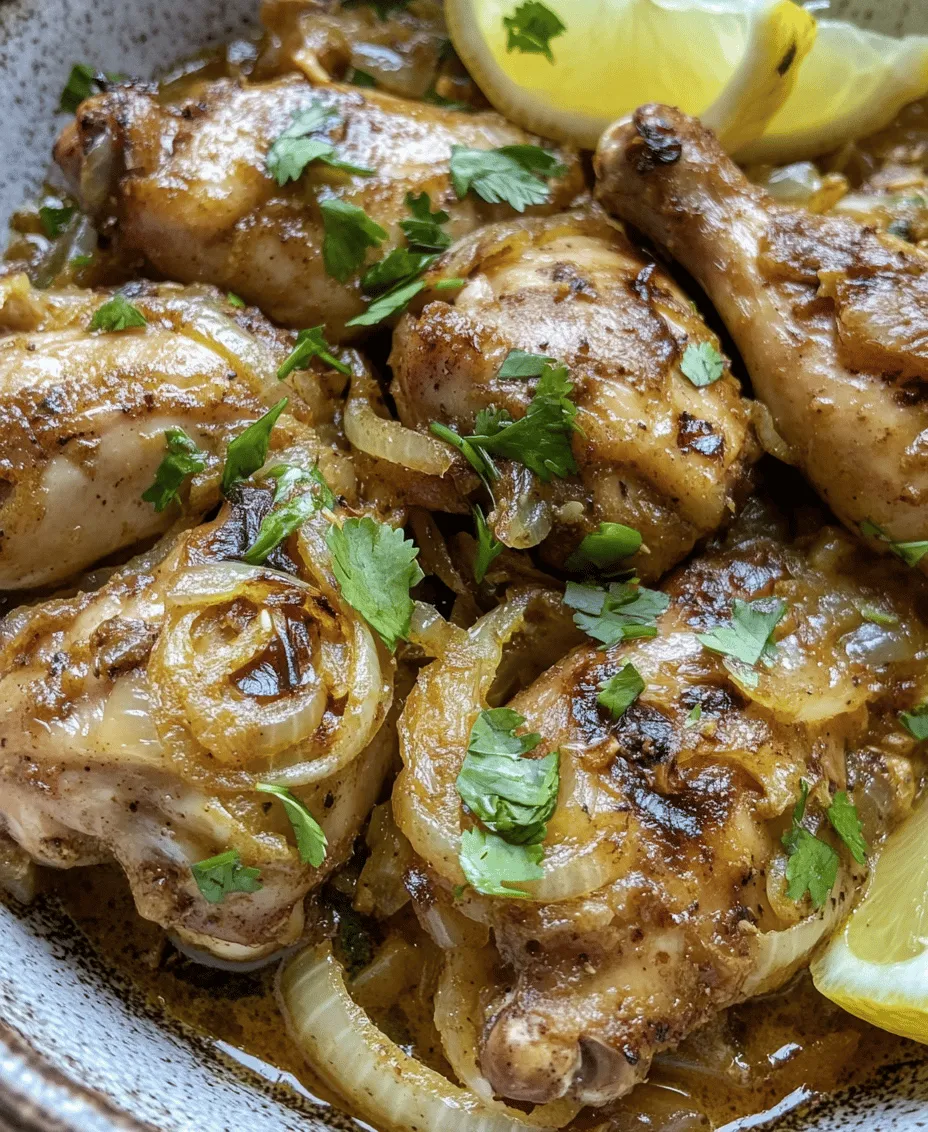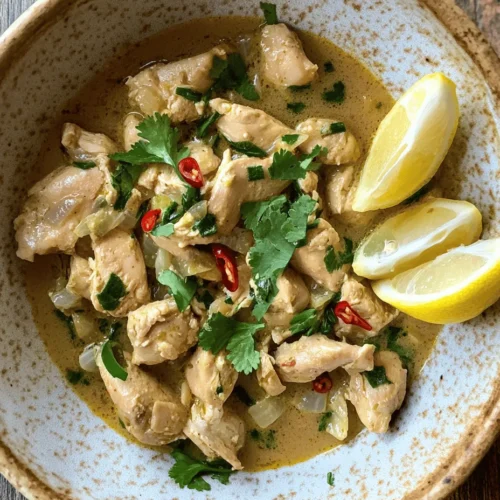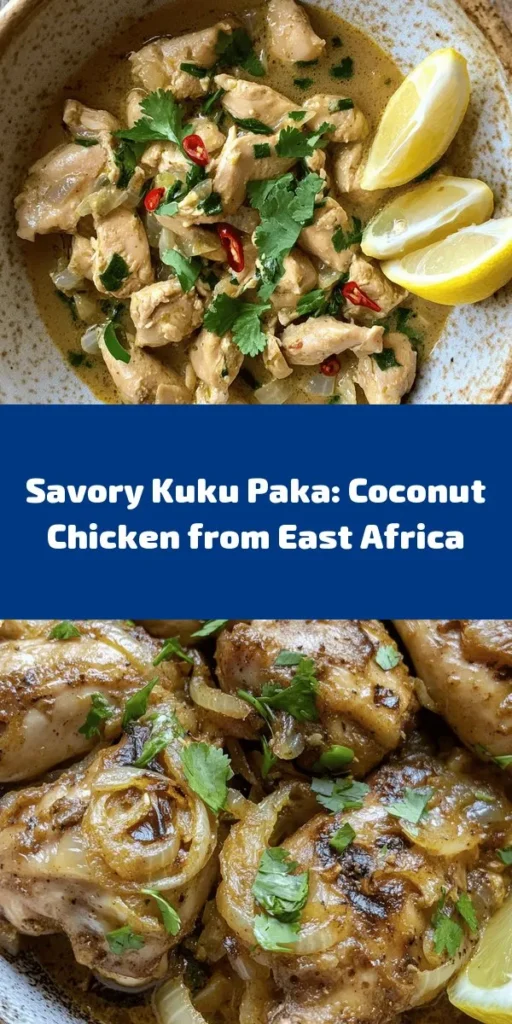Introduction
Kuku Paka, a cherished dish in East African cuisine, is a delightful fusion of vibrant flavors and textures that captures the essence of this culturally rich region. The term “Kuku Paka” translates to “chicken in coconut,” and it embodies the harmonious balance of spices and creamy coconut milk, creating a dish that is as comforting as it is aromatic. With its roots deeply embedded in the culinary traditions of East Africa, Kuku Paka is not merely a meal; it is a celebration of the diverse cultural influences that shape the area, from Swahili coastal traditions to Indian-inspired spices.
Coconut chicken dishes like Kuku Paka hold significant cultural value across East Africa, particularly in countries such as Kenya and Tanzania. Coconut palms thrive along the coastal regions, making coconut a staple ingredient in many local dishes. The incorporation of coconut milk into savory meals has long been a culinary practice, offering a rich and creamy base that enhances the flavors of the ingredients. This dish is versatile enough to be served at casual family gatherings or elegant festive occasions, making it a beloved choice for both everyday dinners and special celebrations.
The appeal of Kuku Paka lies in its unique flavor profile, which combines aromatic spices with the natural sweetness of coconut milk. As you take a bite, the warmth of spices like curry powder and turmeric envelops the tender chicken, while the creamy coconut provides a luscious texture that complements the spices beautifully. This dish is not just about filling the stomach; it is about indulging the senses and enjoying a taste of East Africa.
Understanding Kuku Paka
Kuku Paka has origins that trace back through the centuries, influenced by the rich tapestry of cultures that have interacted along the East African coast. The dish is particularly popular among the Swahili people, who have embraced coconut in their cooking for generations. Alongside traditional African culinary practices, the flavors of Indian, Arab, and Portuguese cuisines have mingled, leading to a unique interpretation of chicken dishes that feature coconut.
The preparation of Kuku Paka can vary significantly from one region to another, reflecting local tastes and available ingredients. In some interpretations, the chicken may be grilled or roasted before being simmered in the coconut sauce, while others may opt for a straightforward stovetop approach. This flexibility allows for personal touches and adaptations, ensuring that every cook can put their unique spin on the dish.
Coconut is a vital ingredient in East African cooking, not only for its flavor but also for its nutritional benefits. Rich in healthy fats, vitamins, and minerals, coconut milk contributes to the overall healthfulness of dishes like Kuku Paka. It is known for its ability to provide a rich source of energy while also being versatile enough to enhance both sweet and savory dishes. By incorporating coconut milk into Kuku Paka, cooks can create a dish that is as nourishing as it is delicious.
The Ingredients of Kuku Paka
To create a truly authentic Kuku Paka, it is essential to gather the right ingredients. Each element plays a crucial role in building the dish’s flavor and texture. Here’s a detailed list of the key ingredients you will need:
Chicken
The star of Kuku Paka is, of course, the chicken. While you can use various cuts, bone-in pieces like thighs and drumsticks are especially popular because they remain tender and juicy during cooking. If you prefer a leaner option, boneless, skinless chicken breasts can also be used, but they may require a bit more attention to avoid drying out. Marinating the chicken before cooking is a critical step that enhances its flavor and tenderness.
Coconut Milk
Choosing high-quality coconut milk is paramount for crafting a rich and flavorful Kuku Paka. Look for brands that contain no additives or preservatives; ideally, the ingredient list should be purely coconut and water. The creaminess of the coconut milk is what makes the dish so indulgent, providing a sweet counterbalance to the spices. If fresh coconut is available, you can also use freshly grated coconut to make your own coconut milk, which will elevate the dish even further.
Spices
The heart of Kuku Paka lies in its spices. A careful blend of curry powder, turmeric, and ground coriander imparts a warm, aromatic flavor profile.
– Curry Powder: This spice mix typically contains various spices, including cumin, coriander, and fenugreek. It adds depth and warmth to the dish while enhancing the overall flavor.
– Turmeric: Known for its vibrant golden color and earthy flavor, turmeric is not only a flavor enhancer but also offers numerous health benefits, including anti-inflammatory properties.
– Ground Coriander: This spice has a citrusy, nutty flavor and adds a fresh note to the dish. It also boasts digestive benefits.
These spices work together to create a well-rounded and flavorful base for the chicken.
Aromatics
Aromatics such as onions, garlic, ginger, and green chilies are essential for developing the depth of flavor in Kuku Paka.
– Onions: Onions provide sweetness and a savory backbone to the dish. The key is to sauté them until they are golden brown, which brings out their natural sugars and adds complexity.
– Garlic and Ginger: These two ingredients are the dynamic duo of flavor in many East African dishes. Garlic adds a pungent kick, while ginger brings a hint of warmth and spice.
– Green Chilies: For those who enjoy a bit of heat, green chilies can be added to the sautéed aromatics. They provide a fresh, spicy flavor that balances the richness of the coconut milk.
Garnishes
Finally, fresh garnishes elevate the presentation and flavor of Kuku Paka. Chopped coriander (cilantro) adds a burst of freshness, while a squeeze of lemon juice brightens the dish, cutting through the richness and enhancing the overall flavor profile.
Preparation Steps for Kuku Paka
Marinating the Chicken
Marinating the chicken is a crucial step in ensuring that the meat absorbs all the delicious flavors of the spices and aromatics. The marinade typically consists of a blend of the spices mentioned earlier, along with salt and a bit of coconut milk.
Importance of Marination for Flavor Enhancement: The marination process allows the flavors to penetrate the chicken, resulting in a more flavorful dish. It is recommended to marinate the chicken for at least 30 minutes, but for optimal results, aim for 2-4 hours or even overnight if time permits. This extended marination time allows the spices to meld and intensify.
Suggested Marination Time and Tips for Effective Marinating: When marinating, ensure that each piece of chicken is evenly coated with the marinade. You can use a resealable plastic bag or a glass dish for marinating. If using a bag, gently massage the marinade into the chicken to ensure it is fully covered. Always refrigerate while marinating to keep the chicken safe from bacterial growth.
Sautéing the Aromatics
Once the chicken has marinated, it’s time to bring the flavors together by sautéing the aromatics. This step is crucial for developing the rich, layered flavors that are characteristic of Kuku Paka.
Techniques for Achieving the Perfect Sauté and the Right Heat Levels: Start by heating a generous amount of oil in a large pot or Dutch oven over medium heat. Once hot, add sliced onions and sauté until they become translucent and start to turn golden brown. This process usually takes about 5-7 minutes.
How to Tell When Onions Are Golden Brown and Why It Matters: The key to achieving the perfect sauté is to watch the onions carefully. They should become a deep golden color without burning. This caramelization is essential as it adds sweetness and complexity to the dish. Once the onions are ready, add minced garlic, grated ginger, and chopped green chilies to the pot. Sauté for an additional 2-3 minutes until fragrant, ensuring that the garlic doesn’t burn.
With the chicken marinated and the aromatics sautéed to perfection, you are now well on your way to creating a mouthwatering Kuku Paka that will not only impress your family and friends but also transport their taste buds straight to the heart of East Africa. In the next section, we will delve deeper into the remaining preparation steps, including cooking the chicken in the coconut milk sauce and final touches that will make your dish shine.

Cooking the Chicken
To achieve the perfect Kuku Paka, the first step is to cook the chicken thoroughly while ensuring it remains tender and juicy. Start by heating a generous amount of oil in a large skillet over medium heat. Once the oil is hot, add the chicken pieces in a single layer, ensuring they have enough space to brown nicely without overcrowding.
Tips on Stirring and Browning Chicken Effectively for Best Results
Browning is crucial for flavor development. After adding the chicken, allow it to sear undisturbed for about 5-7 minutes on one side before flipping. This process creates a caramelized crust that enhances the dish’s overall taste. Use a pair of tongs to turn the chicken pieces gently, ensuring they brown evenly on all sides. Keep an eye on the heat; if it gets too high, the chicken may burn rather than brown. Adjust as necessary to maintain a steady simmer.
Once the chicken is golden brown, remove it from the skillet and set aside. This not only prevents overcooking but also allows you to retain some of the flavorful fond at the bottom of the pan, which will contribute to the depth of flavor in your sauce.
Adding Coconut Milk
With the chicken set aside, it’s time to build the creamy coconut sauce that defines Kuku Paka. In the same skillet, reduce the heat to medium-low and add chopped onions, garlic, and ginger to the remaining oil. Sauté until the onions become translucent and fragrant, typically around 3-5 minutes.
Next, pour in the coconut milk gradually, stirring constantly to incorporate it well with the sautéed aromatics. This step is crucial; you want a smooth, balanced mixture that combines the richness of the coconut with the spices.
Ensuring a Balanced Mixture and the Right Simmering Technique
After incorporating the coconut milk, return the browned chicken to the skillet. Stir gently to coat the chicken pieces evenly with the coconut milk mixture. Bring the mixture to a gentle simmer, allowing the coconut milk to bubble softly without boiling. This simmering technique is vital, as it ensures the flavors meld beautifully and the chicken absorbs the aromatic infusion without becoming tough.
Simmering for Flavor
Simmering is where the magic happens. For Kuku Paka, you’ll want to let the chicken cook in the coconut milk for about 20-25 minutes. This allows the chicken to become tender and soak up the rich flavors of the coconut and spices.
Importance of Simmering Time for Tenderness and Flavor Infusion
During this time, the chicken will not only cook through but will also become infused with the flavors of the spices and coconut milk, creating a harmonious blend that is the hallmark of this dish.
Signs to Look for to Know When the Chicken is Perfectly Cooked
To ensure the chicken is perfectly cooked, check that the internal temperature reaches 165°F (75°C). Additionally, the meat should be tender and easily pull away from the bone if using bone-in pieces. The sauce should have thickened slightly, enveloping the chicken in a creamy coating.
Adjusting Seasoning
Once the chicken is tender, it’s time to adjust the seasoning. Tasting is key to achieving the perfect balance of flavors.
How to Properly Taste and Adjust Flavors to Personal Preference
Start by sampling a small piece of chicken along with a bit of the sauce. If the flavors need enhancement, consider adding salt, a squeeze of fresh lime juice for acidity, or even a pinch of sugar if the dish feels overly salty or acidic. Remember that the goal is to create a well-rounded flavor that highlights the coconut and spices without overpowering the chicken.
Serving Suggestions for Kuku Paka
The way you serve Kuku Paka can elevate the dish from a simple meal to a festive celebration. This dish is traditionally served with sides that complement its rich flavors.
Ideal Accompaniments
Kuku Paka pairs beautifully with steamed rice or chapati, both of which help to soak up the luscious coconut sauce. The neutral flavors of the rice or the warm, soft chapati provide a perfect balance to the dish’s richness.
The Role of Lemon Wedges in Enhancing the Dish’s Flavor
Adding lemon wedges to your serving platter is also a fantastic idea. The bright acidity of the lemon juice can enhance the overall flavor profile of Kuku Paka, adding a refreshing contrast to the creamy sauce.
Presentation Tips for an Appealing Plate
For an appealing presentation, serve the chicken and sauce over a bed of rice. Garnish with freshly chopped cilantro or parsley for a pop of color. Arranging lemon wedges around the plate not only adds vibrancy but also invites diners to squeeze fresh juice over their portions.
Cultural Context for Serving Kuku Paka During Gatherings or Special Occasions
Kuku Paka is often enjoyed during special occasions and gatherings in East African culture. It’s a dish that brings people together, making it perfect for family dinners, feasts, or celebrations. Sharing a meal like Kuku Paka fosters a sense of community and connection, as friends and family come together to enjoy the rich flavors and warm atmosphere.
Nutritional Benefits of Kuku Paka
Kuku Paka not only delights the taste buds but also offers several nutritional benefits.
Analysis of the Nutritional Components of the Dish
The primary ingredient, chicken, serves as an excellent source of protein, essential for muscle growth and repair. Additionally, it contains important vitamins and minerals, including B vitamins that support energy metabolism.
Benefits of Chicken as a Protein Source
Chicken is a lean meat option, making it a healthier choice for those looking to maintain a balanced diet. Consuming chicken can help keep you satiated and energized throughout the day.
Health Advantages of Coconut Milk, Including Healthy Fats
Coconut milk, while rich and creamy, also contributes health benefits. It contains medium-chain triglycerides (MCTs), which are known for their energy-boosting properties and potential to aid in weight management. The healthy fats in coconut milk can also support heart health and improve cholesterol levels.
The Role of Spices in Promoting Health and Well-being
The spices used in Kuku Paka—such as garlic, ginger, and turmeric—are known for their anti-inflammatory and antioxidant properties. Incorporating these spices into your diet can promote overall health and well-being, adding another layer of benefit to this already nutritious dish.
Conclusion
Kuku Paka is a delicious representation of East African cuisine that embodies the rich flavors and warmth of its culture. The combination of tender chicken simmered in creamy coconut milk and aromatic spices makes this dish a true delight for the palate.
Reflecting on the joy of cooking and sharing Kuku Paka with loved ones brings a sense of connection and cultural appreciation that transcends borders. Exploring diverse culinary traditions, like Kuku Paka, not only enriches our dining experiences but also fosters a deeper understanding of the world around us.
As you embark on your culinary adventure with Kuku Paka, embrace the process and enjoy the flavors that come alive in your kitchen. Whether for a casual family dinner or a festive gathering, this dish promises to bring comfort and joy to your table, inviting everyone to savor the delightful tastes of East Africa.



